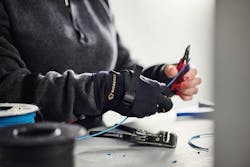Ironhand 2.0
Bioservo Technologies has released an updated version of the exoskeleton glove—Ironhand 2.0, complete with improved activation, better grip, advanced data collection, and much more in order to reduce the occurrence of hand-related repetitive strain injuries (RSIs) in industry workplaces.
Ironhand is the world’s first active soft exoskeleton for the hand, and the grip-strengthening glove won the NASA Commercial Invention of the Year Award in July 2020. It mimics the grasp movements of the user’s hands providing extra strength and endurance to the grip, conserving workers' energy, and reducing the risk of RSIs and other musculoskeletal disorders. Ironhand has since been trialed by workers in manufacturing and other industries prone to repetitive strain injuries, showing promising results. To further develop their invention, Bioservo has also released the IronConnect Pro app. The app collects useful information from the glove when it is in use and summarizes the data into ergonomic risk assessment reports in order to track the risk of injury and prevent it.
The Ironhand system is a smart active exoskeleton, meaning that the glove is activated when the operator starts moving their hand to perform a task, using sensors located on the palm and in the fingers’ tips and middle phalanges. To further improve the glove’s functionality through machine learning, the glove learns from the user and after a while, it can finish a movement or grip at just the slightest flick of the user’s fingers—having learned how the operator moves their hand before and during a certain task.
As the system is connected to the internet through 4G or Wi-Fi, it continuously collects data that can be analyzed. The data collected by the glove when in use is sent to the cloud. The data is used by IronConnect Pro, an application designed to oversee the usage of the exo-glove and maximize benefit through the optimization of the glove’s settings and data. IronConnect Pro can be used with both iOS and Android. With the application, you can see what glove is in use, where it's in use, what operator is using it, what grips it is performing, and much more. Additionally, the app analyzes the data in order to create Ergonomic Risk Assessment reports. This way, users can see if there is a danger of an RSI before it happens—enabling them to take action and prevent the injury before it occurs.
Applications:
- Construction
- Logistics
- Pre-assembly and Assembly
- Warehousing
S, M, L, XL (right and left)Backpack sizesS/M, L/XLHip-carry sizesS, M, LTotal weight of the Ironhand system2,75 kg, approximately 6 lb.Weight worn on the hand50 g, approximately 2 ozMeasures Ironhand Power Pack32 x 12 x 7,5 cmBattery typelithiumBattery timeapproximately 6 to 8 hoursMaximum additional force16 N per finger
